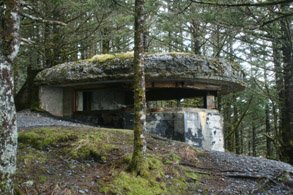Additional Preservation Planning Resources
State Park Plans
The Office of History and Archaeology completed four preservation plans for Alaska State Historical Parks that are recognized as National Historic Landmarks. These plans provide a brief history of the resources, describe current conditions and outline recommendations related to interpretation, partnerships, preservation strategies, and staffing. These plans help the Division of Parks and Outdoor Recreation manage these important places and secure revenue for continued maintenance and renovations.
State Historic Parks Preservation Plans

Historic Structures Reports
Historic structures reports (HSR) help guide historic preservation projects. Oftentimes, a team of preservationists, architects, and conservators create the HSR outlining the historic use, alterations, construction, current conditions, and future work for a specific building. Other components of a HSR could include cost estimates, feasibility, and prioritization of work. A HSR should provide a framework so irreversible damage to the historic property does not occur during proposed work and the best possible preservation outcome is achieved.
Historic Structure Reports
The following resources are helpful when beginning your HSR
- Preservation Brief #17 – Identifying Visual Aspects of Historic Buildings as an Aid to Preserving Their Character
- Preservation Brief #18 – Identifying and Preserving Character Defining Elements
- Preservation Brief #43 – Historic Structure Reports
- Secretary of the Interior's Standards for Treatment of Historic Properties
Archaeological Planning
The National Strategy for Federal Archaeology prefers preserving or conserving important archaeological sites in place. Best practices dictate that sites should be stabilized so excavation can be systematic and new technologies can aid in information collection with less damage to the resource. Natural threats such as erosion can be addressed as well as cultural threats such as looting or development. The Office of History and Archaeology completed several cultural resource management plans to protect and conserve important archaeological resources on state lands.
Existing Cultural Resource Plans
- Cultural Resource Plan for the Denali Highway Lands
- Slikok Creek, Kenai River Special Management Area Cultural Resources Management Plan
Oil Spill Response Planning
The 1989 EXXON VALDEZ oil spill and response activities that followed necessitated the development of emergency and long-term measures to protect cultural resources along Alaska's affected coastline. The Alaska State Historic Preservation Office (SHPO) played a key role in developing and monitoring these efforts, along with other government and industry cultural resource specialists. In many ways, the response to cultural resources and quick development of an infrastructure to address the challenges were unprecedented. There were lessons learned as protocols, guidelines, and organizational structure evolved over the course of several field seasons. One of the important accomplishments in the aftermath of the EXXON VALDEZ oil spill was the development of a "National Programmatic Agreement on Protection of Historic Properties During Emergency Response Under the National Oil and Hazardous Substances Pollution Contingency Plan" and the complimentary "Alaska Implementation Guidelines for Federal On-Scene Coordinators." The Alaska Office of History and Archaeology, working with other Alaska agencies and contractors, has compiled an Annotated Guide to Posted Oil Spill Documents during the Exxon Valdez spill response.
